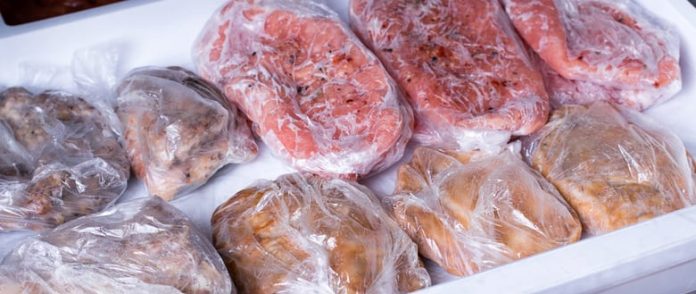Tips
Freezing meat is an extraordinary method to store and shield it from waste. New meat can in fact last endlessly when put away at the right temperature, so the capacity rules allude to the quality and kind of the actual meat.
Following security safety measures lessens the shot at decay, too. A few coolers will be unable to keep the temperature reliably adequately low, so capacity times can differ.
Even in the wake of following the right wellbeing and capacity strategies, individuals ought to keep away from any meat that looks or scents odd.
Freezing meat is an extraordinary method to save the dietary benefit and hold it back from ruin. Contingent upon the cut and kind of meat, uncooked meats might protect in the cooler and stay at a great for somewhere in the range of 1 a year.
Follow the right rules to store and freeze the meat to guarantee its wellbeing and forestall bacterial development.
This article will talk about the significance of securely putting away meat and blueprint probably the prescribed procedures for putting away and freezing various sorts of meat.
The importance of safely storing meat
Safe storage can protect meat against quality and flavor loss as well as bacterial growth.
The United States Department of Agriculture (USDA) note that safely storing meat in the freezer at 0°F (-18°C) reduces the temperature to a point that inhibits most bacterial growth.
Warmer temperatures than this can allow bacteria to grow on the meat, which can make a person sick. This is why meat stored in the refrigerator typically only lasts for a few days. The cooler temperatures can slow some bacterial growth but are not enough to keep the food from spoiling.
Proper freezing also protects against pathogenic bacteria, which are the bacteria behind foodborne illnesses and food poisoning.
Safe storage also protects the meat from flavor and quality loss. Several compounds in meat oxidize and break down rather quickly at room temperature, which can lead to a noticeable loss of flavor.
Proper storage techniques — such as curing, smoking, and freezing — may help slow this process or prevent some or all quality loss.
Some of the best practices for storing and freezing meat include:
Preparing meat for freezing
In most cases, it is OK to store meat purchased from a market in the package it came in. Check for any holes or breaks in the package first, but an airtight package will keep the meat safe at the recommended temperature.
For butchered meat, wrap the cuts in an airtight package first. The Food and Drug Administration (FDA)Trusted Source recommends overwrapping the packaging with airtight foil or plastic wrap if freezing for longer than 2 months.
Freezing temperature
Freezing temperature is a crucial aspect of storing meat. People should keep meat frozen at a temperature of 0°F (-18°C) or below. The USDA noted that this temperature inhibits the growth of bacteria and shuts down any other microbes, such as yeasts and molds, in the food.
People can use a thermometer to check whether or not their freezer will reach this temperature. Some freezers that see frequent use may not reach temperatures this low consistently, which may put the food at risk of bacterial growth and spoilage.
Thawing meat
There are three main ways to defrost and thaw meat from the freezer.
The slowest and perhaps safest technique is to thaw the sealed package in the refrigerator. Smaller cuts of meat may defrost in a few hours, whereas larger cuts of meat may take a few days to defrost.
To safely thaw meat faster, a person can place it in a leakproof plastic bag and set it in a tub of cold water. They should change the water every 30 minutes and cook the meat immediately after thawing.
Some microwaves also have specific settings to help defrost frozen meat. If using the microwave method, cook the meat immediately after defrosting it.
Never thaw meat out in the open at room temperature, such as on a counter or in the sink. The Centers for Disease Control and Prevention (CDC)Trusted Source notes that bacteria can multiply quickly at room temperature.
Refreezing meat
Once raw meat has been defrosted properly, many experts recommend not freezing it again unless the person cooks it first. This is mainly to prevent texture and quality loss.
Raw meat defrosted in the refrigerator is still technically safe to freeze again, though the quality may suffer due to moisture loss.
When defrosted and refrozen, the meat will create more ice crystals within its cells. These ice crystals rupture the tissue of the meat on a microscopic level that can change the taste and texture of the meat.
Defrosting and refreezing the meat again may cause a notable difference in quality. The meat may be very dry or lose some of its texture.
After cooking defrosted foods thoroughly, it is safe to freeze them again.
How long to freeze meat
The FDATrusted Source notes that freezing meat at 0°F (-18°C) will technically preserve it indefinitely. However, the quality of the meat may drop after some time, and very long freeze times may cause noticeable changes in the quality and taste of the meat.
Because of this, various types of meat have different storage lengths to ensure that they are still high quality once thawed out to eat.
The sections below outline how long to freeze meat based on the type of meat:
Fresh meat
Fresh meat will generally have the longest shelf life and can last the longest in the freezer without losing quality.
Ground meats
- Raw hamburger meat: 3–4 months
- Raw ground turkey, veal, pork, or lamb: 3–4 months
Fresh beef, veal, lamb, and pork
- Steak: 6–12 months
- Roasts: 4–12 months
- Chops: 4–6 months
- Other cuts, such as liver, tongue, and chitterlings: 3–4 months
- Bacon: 1 month
- Raw sausage: 1–2 months
Raw poultry, such as chicken or turkey
- Whole: 12 months
- Parts: 9 months
- Giblets: 3–4 months
Fish and shellfish
- Lean fish: 6–8 months
- Fatty fish: 2–3 months
- Fresh shellfish and squid: 3–6 months
Cooked meats
Processing, cooking, or smoking the meat drastically reduces this time in many cases, as the quality of the meat will suffer after freezing again.
Refreezing cooked meats may also taint the flavor of the meat, as some flavors oxidize and break down after cooking — even in the freezer.
With this in mind, here are the freezing times for cooked meats:
Lunch meats
- Hot dogs: 1–2 months
- Lunch meats: 1–2 months
- Ham (whole, half, or slices): 1–2 months
- Corned beef (drained): 1 month
Cooked meat
- Smoked sausage products: 1–2 months
- Meat leftovers from beef, veal, lamb, and pork: 2–3 months
- Gravy, meat broth, and stews containing meat: 2–3 months
Cooked poultry, such as chicken or turkey
- Pieces: 4 months
- In gravy: 6 months
- Fried: 4 months
- Nuggets or patties: 1–3 months
Fish and shellfish
- Cooked fish: 4–6 months
- Smoked fish: 2 months
- Canned fish (out of the can): 2 months
































